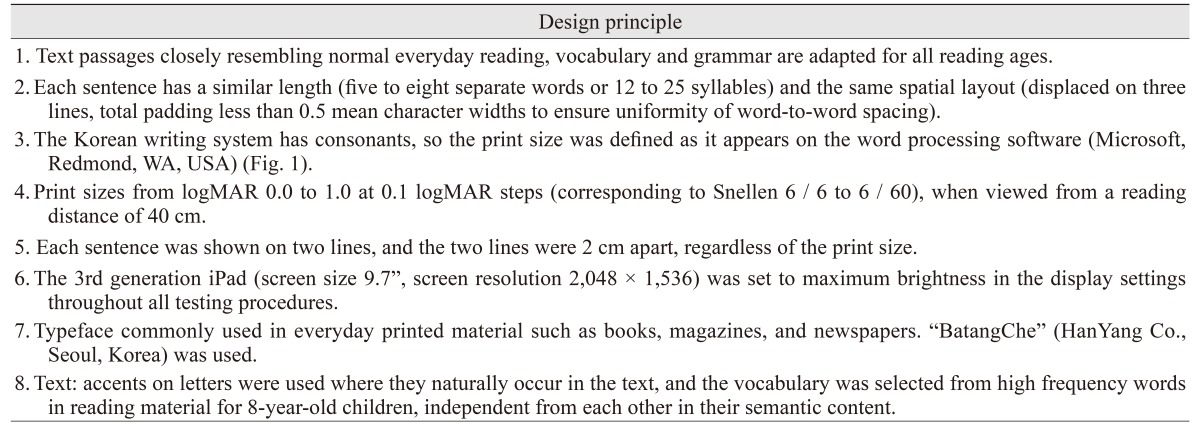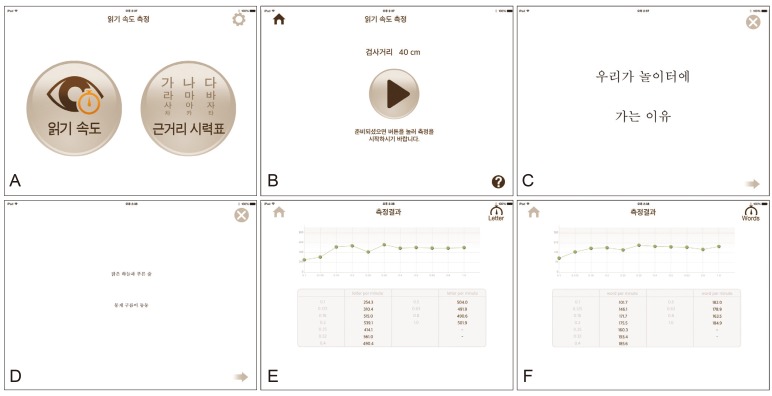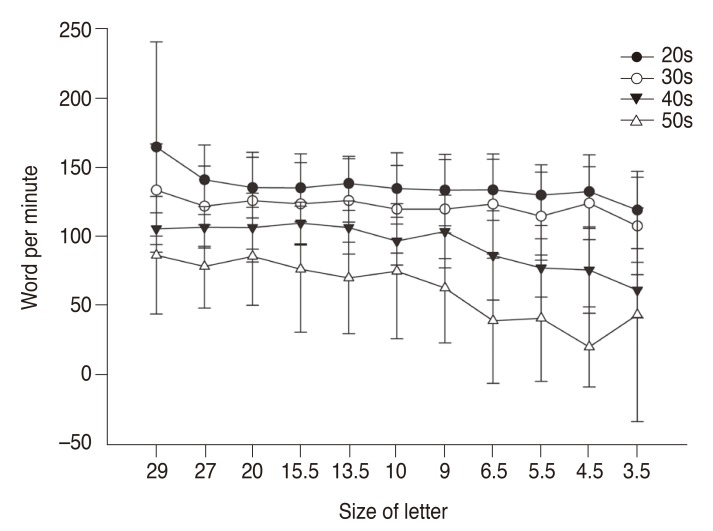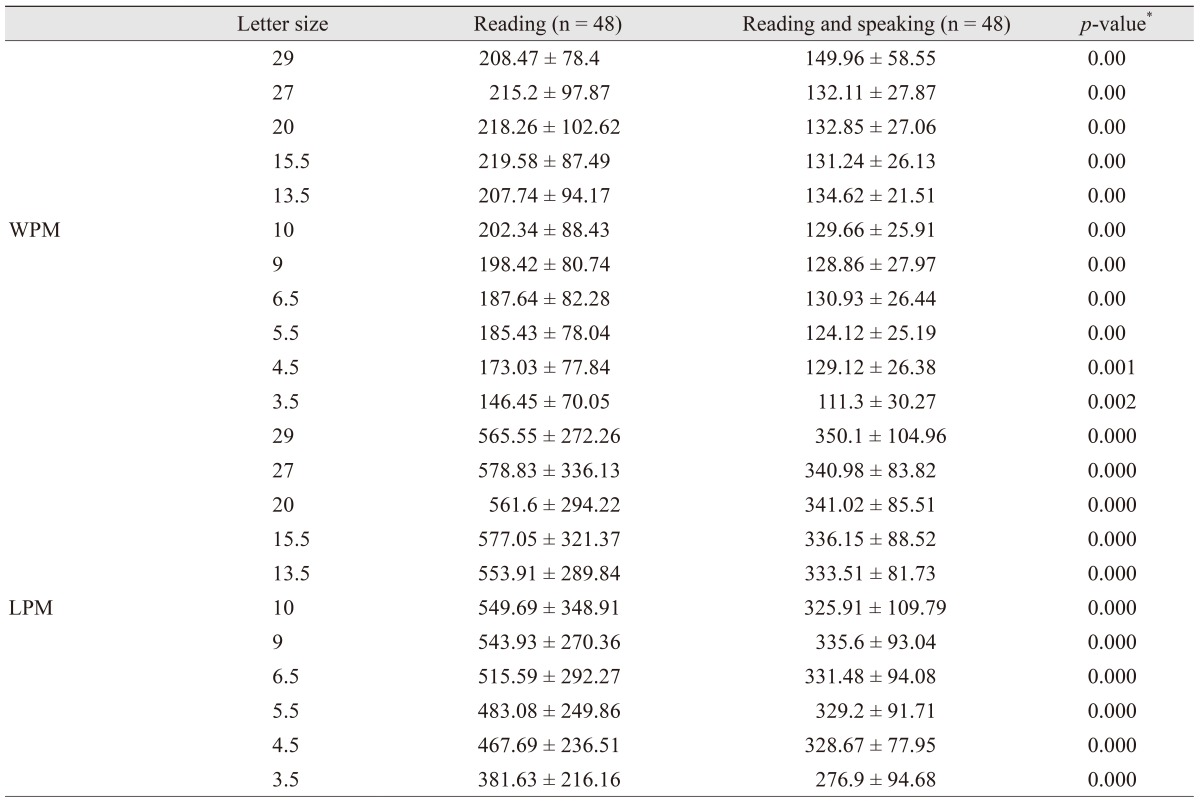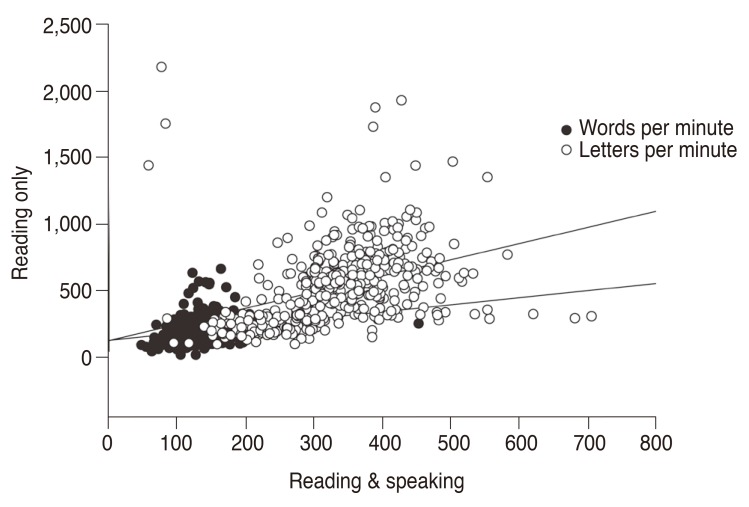Abstract
Purpose
This study introduces a reading chart application for the iPad tablet in the Korean language and investigates the reading speed in a normal-sighted population according to age group.
Methods
Sixty-three Korean sentences were selected from textbooks for second grade elementary school students. A commonly used typeface in everyday printed material, “BatangChe,” was used. Letter size was presented in logarithm of the minimum angle of resolution (logMAR) 0.0 to 1.0 at 0.1 logMAR steps at a reading distance of 40 cm. A third generation retina display iPad was used to present the chart, and the sentences were presented randomly for each size of letter. The subjects repeated the test silently (reading only) and out loud (reading and speaking) to prevent them from skipping reading words. Pilot testing followed in 65 normal vision adults under 60 years of age.
Results
The mean reading only speed for logMAR 0.5 optotype (point 10) was 121.1 ± 47.2 words per minute (wpm) for people in their 20s (n=21), 116.5 ± 38.3 in their 30s (n=27), 93.8 ± 12.6 in their 40s (n=9), and 56.5 ± 42.7 (n=8) in their 50s. There was a significant correlation between age and reading and speaking speed (r=-0.48, p<0.001). The mean reading only speed for logMAR 0.5 optotype (point 10) was 202.3 ± 88.4 wpm and the mean reading and speaking speed was 129.7 ± 25.9 wpm, with significantly different (p<0.001).
Conclusions
This Korean reading chart application could present a new standard when checking reading speed according to age groups.
Keywords: App, Application, iPad, Korean, Reading speed
Reading is closely linked to the quality of life of an individual [1], and assessing a subject's reading ability is an important part of an eye examination [2]. It is essential that this assessment is done in a standardized way that ensures reliable, repeatable results that accurately reflect visual circumstances [2].
Currently, several charts for testing near vision with different scales and notations (e.g., Jaeger, Neiden, Parinaud) are available [3,4,5]. However, most of these charts suffer from a lack of standardization of the test items [6]. Their print sizes (letter heights) are not standardized, are not logarithmically scaled, and mostly remain unknown because of the limitations of earlier printing techniques [6].
Increasing demands for standardized reading charts have led to newly developed charts. Legge et al. [7,8] developed the computer-based Minnesota Low-Vision Reading Test (MNread), which presents short sentences for decreasing time periods on a computer screen. The sentences of the MNread chart have three lines and 60 characters; however, their number (10 to 14 words) and length and the position of words vary considerably. It is assumed that this format represents 10 words of “average” English length (six characters). Reading speed is calculated as the number of words correctly read divided by the time of presentation. Subsequently, Bailey and Lovie [9] described a new near-vision chart and suggested it is possible to determine reading speed and reading acuity with short words (a few single words in row). However, there are differences in the philosophy of sentence standardization between MNread and Bailey and Lovie's chart systems, both of which use single sentences.
In contrast, Radner et al. [10,11] developed the Radner reading charts, which are based on the concept of using sentence optotypes for the standardized examination of reading acuity and reading speed. The sentences on these charts were created to minimize variations between the test items and to keep the geometric proportions as constant as possible to allow accurate, standardized measurements of reading acuity and/or reading speed at every viewing distance. The optotypes consist of short single sentences that are highly comparable in syntactical structure; number, length, and position of words; and lexical difficulty.
The Korean writing system is ‘alpha-syllabary’ and is known as Hangul [12]. Hangul has 24 symbols (14 basic consonant letters and 10 basic vowel letters), each representing a phoneme (e.g., consonant, “ㄱ, ㄴ, ㄷ, ㄹ, ㅁ, ㅂ, ㅅ, ㅈ, ㅊ, ㅋ, ㅌ, ㅍ, ㅎ”; vowel, “ㅏ, ㅑ, ㅓ, ㅕ, ㅗ, ㅛ, ㅜ, ㅠ, ㅡ, ㅣ) [13]. Hangul is fundamentally based on an alphabetic principle, and letters are printed in syllable blocks composed of three consonants (first, medial, and final consonants), up to four graphemic elements per syllable (e.g., 감 is composed of three elements; ㄱ, ㅏ, and ㅁ) [14]. Korean has a nonlinear spatial layout; its graphemes are composed in a square-like block, in which the graphemes are arranged left to right and top to bottom. Because the Hangul syllable blocks are separated, there is a clear syllable boundary. The clear-cut syllable boundaries in Korean Hangul may make its morphemes more visible than linear orthographic systems such as English [15].
Although MNread charts and the Radner reading charts are available in several languages, no near vision test with the advantages of these charts are available in Korean. Therefore, the aim of the present study was to introduce a reading speed chart in Korean in the form of an application (app) that can be used on an iPad tablet computer (Apple Inc., Cupertino, CA, USA).
Materials and Methods
A Korean version of a reading chart was developed based on a series of design principles similar to the MNread chart (Table 1) [2].
Table 1. Summary of Korean version reading chart design principles.
logMAR = logarithm of the minimum angle of resolution.
Study population
The study population consisted of native Korean-speaking individuals whose best-corrected visual acuity was examined with the Early Treatment Diabetic Retinopathy Study charts at 4 m and was at least 0.0 logarithm of the minimum angle of resolution (logMAR; decimal, 1.0; Snellen, 6 / 6) in each eye, and none of the participants suffered from disease or were taking a medication that could influence the results of the study. Tests were performed binocularly. Binocular reading acuity at 40 cm was at least at logarithm of the reading acuity determination (logRAD) 0.1 (decimal, 0.8; Snellen, 6 / 7.5; logRAD, reading equivalent of logMAR). The study was approved by the National University Human Ethics Committee. All participants provided full, written informed consent and all study protocols were in accordance with the Declaration of Helsinki.
Sentence optotypes
The sentence optotypes were second grade complex sentences, representing easily readable adult sentences. Sixty-three Korean sentences were selected from textbooks for second grade students in elementary school. A commonly used typeface in everyday printed material, “BatangChe (HanYang Co., Seoul, Korea)” was used. The sentences were developed to be as comparable as possible in terms of grammatical difficulty as well as in length and position of words.
Apparatus and testing procedure
Reading speed was measured using a third generation Apple iPad (iPad Retina Display, Apple Inc.). The iPad (screen size 9.7”, screen resolution 2,048 × 1,536) was set to maximum brightness in the display settings throughout all testing procedures. Our Korean version reading speed app (Fig. 1A-1F) contains a stop clock so that when a participant presses the start button (Fig. 1B), the first sentence appears (Fig. 1C). The participant was asked to read the sentence out loud and then go on to the next stage, which was a sentence in a smaller print (Fig. 1D). When the participant is finished, the app automatically calculates the reading speed in words per minute (WPM) and letters per minute (LPM) (Fig. 1E and 1F). Participants between 20 to 59 years old were asked to read the sentence silently (reading only) and out loud (reading and speaking). Reading speeds (WPM and LPM) were recorded according to the size of letters used for testing near visual acuity which were modified from previous literature [16]. The test room was lit by fluorescent tubes (Feelux T4-HE18W65; Feelux co., Yangju, Korea) that gave a quoted color temperature of 6,500 K with a color-rendering index of 98 (to stimulate daylight). Comparisons of reading speeds according to age, gender, and between reading only and reading and speaking were performed and the correlation between WPM and LPM was analyzed.
Fig. 1. Testing procedure for Korean version reading speed chart on the first page of the app, the reading speed chart (the left button) can be selected (A). Participant presses the start button (B) and the first sentence would appear (C). The participant was asked to read out loud the sentence and then go on to the next stage which showed a smaller print sentence (D). When the participant finally finished, the application would automatically calculate the reading speed as words per minute and letters per minute (E,F).
Statistical analysis
Data are presented as the mean ± standard deviation unless otherwise specified in the text. Differences were analyzed using the SPSS ver. 14.0 (SPSS Inc., Chicago, IL, USA) and Medcalc ver. 14.8.1 (Medcalc, Ostend, Belgium). Correlations between continuous variables were analyzed using the Pearson correlation test and linear regression. The ratio of males and females according to age group was compared using the chi-square test. The paired t-test was used to compare pairs of dependent groups, and Student's t-test for two independent groups. Two-sided p-values <0.05 were considered statistically significant.
Results
Study population
The study population consisted of 65 native Korean speakers (35.6 ± 10.1 years, 22–59 years), and 33 subjects were male and 32 subjects were female. Demographics according to age groups are presented in Table 2 and there were no statistically significant differences among the age groups.
Table 2. Demographic characteristics.
Values are presented as mean ± standard deviation.
CDVA = corrected distance visual acuity; OD = right eye; OS = left eye; SE = spherical equivalent.
*Chi-square test, p-value >0.05; †Pearson correlation test, p-value >0.05.
Sentence optotypes
The 63 sentences were developed with 6.5 ± 0.7 (5–8) words per sentence, with 18.9 ± 2.6 (13–25) letters per sentence.
Analysis of Korean sentence reading speed
The average reading and speaking speeds for each size of letter according to age are shown in Fig. 2. The mean reading and speaking speed for logMAR 0.5 optotype (point 10) was 121.1 ± 47.2 wpm for people in their 20s (n=21), 116.5 ± 38.3 in their 30s (n=27), 93.8 ± 12.6 in their 40s (n=9), and 56.5 ± 42.7 (n=8) in their 50s. There was a significant correlation between age and reading only speed (r=−0.48, p<0.001). There were statistically significant decreases in reading speed for each size of letter according to increases in age (Fig. 2). The averages of reading only speed and reading and speaking speed for each size of letter are shown in Table 3. The mean reading only speed for logMAR 0.5 optotype (point 10) was 202.3 ± 88.4 wpm and the mean reading and speaking speed was 129.7 ± 25.9 wpm, with a significant difference (p<0.001). Reading only speeds for all sizes of letter were significantly faster than reading and speaking speeds. WPM and LPM had statistically significant correlations in both reading only (r2=0.84, p<0.001) and reading and speaking speed (r2=0.41, p<0.001). In Fig. 3, reading only speed and reading and speaking speed had statistically significant correlations in both WPM (r2=0.04, p<0.001) and LPM (r2=0.15, p<0.001).
Fig. 2. Mean reading speed (reading & speaking) of each age group in each print size.
Table 3. Comparison of reading speed (reading only and reading and speaking).
Values are presented as mean ± standard deviation.
WPM = words per minute; LPM = letters per minute.
*Paired t-test, p-value <0.05.
Fig. 3. Correlation between the two reading speed (reading only and reading & speaking) in words per minute (WPM) and letters per minute (LPM). WPM and LPM had statistically significant correlations in both reading only (r2=0.84, p<0.001) and reading & speaking speed (r2=0.41, p<0.001).
Discussion
This app is the first near reading speed chart available in Korean. Studies measuring Korean reading speed have previously been translated from the English version of MNRead charts, but these charts have not been validated [17]. There have been studies randomly showing Korean words measuring reading speed by WPM, but the words were not shown in a sentence structure and the size of the letters was all the same, so differences in reading speed according to letter size were not measured [18,19,20].
In this study, the average reading and speaking speed for logMAR 0.5 optotype in 20s and 30s was about 130 ± 25.9 wpm. The Korean reading and speaking speed for patients after multifocal intraocular lens implantation was about 100 wpm by the MNRead chart [17]. The subjects in this study were older and presbyopia was not compensated, so our results were slower than a previous study by Kim et al. [17] The reading and speaking speed measured by Korean charts consisting of unrelated words was 80 to 110 wpm [18,19,20]. The fact that the subjects were younger or had a specific disease may explain the differences with our study. In addition, compared to unrelated words, charts with meaningful text may overestimate reading and speaking speed, as the subject can infer words by context [21]. However, reading and speaking speed of charts consisting of meaningful texts or unrelated words highly correlate [22], and we think that charts with meaningful sentences, as in this app, reflect everyday performance more accurately.
The advantage of this app is the self-testing method used. Previous reading speed charts recorded subjects reading out loud and calculated the time and then checked reading errors. This app skips this process and automatically calculates reading speed, saving significant time and manpower. However, when used without the reading out loud component, errors cannot be checked, so accuracy or repeatability may be lower than previous reading speed charts. Although the correlations between reading only speed and reading and speaking speed had statistical significance in this study, the coefficients of determination (r2) were relatively low. Further studies comparing this app with previous reading charts by recording the subject reading out loud will yield more information on the differences between the reading speed charts.
The second advantage is that we can measure both reading speed and speaking speed. As previous charts required subjects to read out loud, they actually measured “speaking speed,” although this was named “reading speed.” As this app automatically measures reading speed, the “reading only” speed and “reading while speaking speed” can be measured separately, and the present study found that reading only speed is much faster than speaking speed (Table 3).
In addition, this app presents WPM and LPM data separately, so that it can be analyzed separately. The present study showed that WPM and LPM highly correlated in both reading speed and speaking speed. As previous reading charts cannot change sentences, they validated sentences by a sentence length validation method. However, this app randomly extracts sentences and enables analyses of both WPM and LPM, which supplements the fact that the sentences were not validated in previous reading charts.
There are several limitations to the present study. First, we cannot directly compare results with other reading charts, as no Korean reading speed chart has been previously developed. Therefore, the validity and repeatability of this reading speed test app has yet to be properly evaluated. As Korean has a nonlinear spatial layout, further studies in conjunction with linguistic departments are needed to compare Korean reading charts with other language charts and to evaluate their validity and repeatability. Sentence length validation was also not performed. However, while previous charts contained one sentence per letter size, this app randomly extracts sentences according to letter size and measures the reading speed twice per letter size and shows both WPM and LPM, compensating for this limitation. In addition, the subjects in this study were highly cooperative healthy volunteers, so results may differ in the general population. For example, for cognitive function disorder patients, the result of this app could be a false positive. On the other hand, for dyslexia patients who do not want to acknowledge their disorder, the result of this app could be a false negative. Therefore, this app may be most useful for cooperative patients who are willing to determine their exact reading function. In such cases, this may be a useful screening test for ophthalmic or cognitive disease. Finally there were too small number of subjects to figure out critical print size for 40s and 50s. Further studies are required with a greater number of subjects.
In conclusion, this is the first study employing a Korean reading speed chart app. As it uses the iPad, this chart is easy to access, highly efficient, more portable and cost-effective, as it is performed by the self-testing method. This study suggests guidelines for reading and speaking speed according to age groups in the Korean language and can be used in further studies investigating reading speed.
Footnotes
Conflict of Interest: No potential conflict of interest relevant to this article was reported.
References
- 1.Chia EM, Wang JJ, Rochtchina E, et al. Impact of bilateral visual impairment on health-related quality of life: the Blue Mountains Eye Study. Invest Ophthalmol Vis Sci. 2004;45:71–76. doi: 10.1167/iovs.03-0661. [DOI] [PubMed] [Google Scholar]
- 2.Mataftsi A, Bourtoulamaiou A, Haidich AB, et al. Development and validation of the Greek version of the MNREAD acuity chart. Clin Exp Optom. 2013;96:25–31. doi: 10.1111/j.1444-0938.2012.00799.x. [DOI] [PubMed] [Google Scholar]
- 3.Friedman SM, Munoz B, Rubin GS, et al. Characteristics of discrepancies between self-reported visual function and measured reading speed: Salisbury Eye Evaluation Project Team. Invest Ophthalmol Vis Sci. 1999;40:858–864. [PubMed] [Google Scholar]
- 4.Rubin GS, West SK, Munoz B, et al. A comprehensive assessment of visual impairment in a population of older Americans: the SEE Study. Salisbury Eye Evaluation Project. Invest Ophthalmol Vis Sci. 1997;38:557–568. [PubMed] [Google Scholar]
- 5.West SK, Munoz B, Rubin GS, et al. Function and visual impairment in a population-based study of older adults: the SEE Project. Salisbury Eye Evaluation. Invest Ophthalmol Vis Sci. 1997;38:72–82. [PubMed] [Google Scholar]
- 6.Radner W, Diendorfer G. English sentence optotypes for measuring reading acuity and speed: the English version of the radner reading charts. Graefes Arch Clin Exp Ophthalmol. 2014;252:1297–1303. doi: 10.1007/s00417-014-2646-y. [DOI] [PubMed] [Google Scholar]
- 7.Legge GE, Ross JA, Isenberg LM, LaMay JM. Psychophysics of reading: clinical predictors of low-vision reading speed. Invest Ophthalmol Vis Sci. 1992;33:677–687. [PubMed] [Google Scholar]
- 8.Legge GE, Ross JA, Luebker A, LaMay JM. Psychophysics of reading: VIII. the Minnesota Low-Vision Reading Test. Optom Vis Sci. 1989;66:843–853. doi: 10.1097/00006324-198912000-00008. [DOI] [PubMed] [Google Scholar]
- 9.Bailey IL, Lovie JE. The design and use of a new near-vision chart. Am J Optom Physiol Opt. 1980;57:378–387. doi: 10.1097/00006324-198006000-00011. [DOI] [PubMed] [Google Scholar]
- 10.Radner W, Obermayer W, Richter-Mueksch S, et al. The validity and reliability of short German sentences for measuring reading speed. Graefes Arch Clin Exp Ophthalmol. 2002;240:461–467. doi: 10.1007/s00417-002-0443-5. [DOI] [PubMed] [Google Scholar]
- 11.Radner W, Willinger U, Obermayer W, et al. A new reading chart for simultaneous determination of reading vision and reading speed. Klin Monbl Augenheilkd. 1998;213:174–181. doi: 10.1055/s-2008-1034969. [DOI] [PubMed] [Google Scholar]
- 12.Yoon K, Brew C. A linguistically motivated approach to grapheme-to-phoneme conversion for Korean. Comput Speech Lang. 2006;20:357–381. [Google Scholar]
- 13.Cho JR, Chen HC. Semantic and phonological processing in reading Korean Hangul and Hanja words. J Psycholinguist Res. 2005;34:401–414. doi: 10.1007/s10936-005-6140-x. [DOI] [PubMed] [Google Scholar]
- 14.Cho JR, McBride-Chang C, Park SG. Phonological awareness and morphological awareness: differential associations to regular and irregular word recognition in early Korean Hangul readers. Read Writ. 2008;21:255–274. [Google Scholar]
- 15.Wang M, Ko IY, Choi J. The importance of morphological awareness in Korean-English biliteracy acquisition. Contemp Educ Psychol. 2009;34:132–142. [Google Scholar]
- 16.Kniestedt C, Stamper RL. Visual acuity and its measurement. Ophthalmol Clin North Am. 2003;16:155–170. doi: 10.1016/s0896-1549(03)00013-0. [DOI] [PubMed] [Google Scholar]
- 17.Kim JH, Lee JW, Chung JL, et al. Combined implantation of monofocal and multifocal intraocular lenses in senile cataract surgery. J Korean Ophthalmol Soc. 2009;50:1632–1638. [Google Scholar]
- 18.Lee KB, Lee HJ, Jun SW, et al. A study of correlation among visual-verbal skills, binocular vision and school achievement. Korean J Vis Sci. 2008;10:197–216. [Google Scholar]
- 19.Lee SJ, Park JH, Lee SH, et al. The study on improvement of reading ability for Dyslexia wearing color filter lens (ChromaGenTM lens) J Korean Ophthalmic Opt Soc. 2011;16:65–74. [Google Scholar]
- 20.Park SH, Kim SH, Cho YA, Joo CK. The effect of colored filters in patients with Meares-Irlen syndrome. J Korean Ophthalmol Soc. 2012;53:452–459. [Google Scholar]
- 21.Sloan LL, Brown DJ. Reading cards for selection of optical aids for the partially sighted. Am J Ophthalmol. 1963;55:1187–1199. [Google Scholar]
- 22.Rubin GS. Visual acuity and contrast sensitivity. In: Ryan SJ, editor. Retina. St. Louis: Mosby; 2013. pp. 300–306. [Google Scholar]



